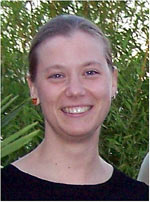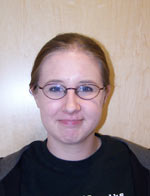2007 Capstone Celebration Symposium
PLU Chemistry Department
May 1st to May 4th, 2007
Come and join the Chemistry department to hear the senior capstone presentations. Student presentations will occur Tuesday through Friday. The schedule of talks with more details is given below.
[ Tuesday | Wednesday | Thursday | Friday ]
All talks will be held in the Morken Center in Room 103!
1:00 pm - Analysis of Microbial Communities in Forest Canopy Soil using Biolog Ecoplates and Non-metric Multidimensional Scaling
Elizabeth Sloan, Senior Capstone Seminar
Using Biolog Ecoplates analysis of microbial communities from canopy soil in the Gifford Pinchot National Forest was analyzed. The plates provide information on the utilization of 31 different carbon sources selected for their ability to distinguish between ecological communities through spectrophotometric analysis of a reduced tetrazolium dye. These carbon sources are indicators of specific metabolic pathways and enzymes. Itaconic acid is produced in fungi and is often an inhibitor of microbial growth due to limited ability to break it down. β-methyl-D-glucoside is produced by plants and can only be broken down by microbes. This metabolism has been shown using a family 1 β-glucosidase that is made up of a (βα)8 barrel which is responsible for breaking down other glucosides. Analysis showed differences in canopy and ground soil communities. Nonmetric Multidimensional Scaling (NMS) analysis showed differences in soil communities due to height above ground, tree species and location of sampling site.

1:40 pm - Surface-Enhanced Raman Spectroscopy Using Colloidal Gold Nanoparticles
Christopher Bingham, Senior Capstone Seminar
Colloidal gold nanoparticles were synthesized and employed in SERS studies of several small molecules. Several synthetic methods were explored in an effort to optimize the SERS activity of the nanoparticles. Hydrogen tetrachloroaurate was reduced using sodium thiosulfate. Aggregation of the resultant nanoparticles was controlled by subsequent addition of sodium sulfate which was found to be responsible for making the nanoparticles SERS active. Sulfate, acting as a capping agent, created an attraction between the anion and the molecule, which is necessary for adsorption. Once the molecule was attached to the surface of the nanoparticle, an enhanced Raman signal was observed. Rhodamine 6G (R6G) was the primary molecule used to test for SERS activity, to aid in comparison to previous research conducted by other groups. Other molecules studied include fluorescent dyes, creatinine, and amino acids. The presence of a terminal Nitrogen increases the likelihood of a SERS spectrum for the molecule.

2:20 pm - Evaluation of Whole Blood DNA Extraction Methodology for End Use Quantitative Real Time-Polymerase Chain Reaction Amplification
Debra George, Senior Capstone Seminar
The purpose of this investigation was to determine the optimal DNA extraction method for murine whole blood minus plasma in order to obtain not only the highest possible yield but also perform well in the end use assay of quantitative Real-Time Polymerase Chain Reaction (qRT-PCR). Commercially available DNA tissue and blood extraction kits designed for end-use PCR applications were examined and the resulting DNA yield and purity was examined using standard spectrophotometry and quantitative real-time PCR methods. The Promega Wizard ® DNA Extraction Kit was found to yield the highest concentration of DNA with acceptable purity but failed to produce true amplification in the qRT-PCR assay until after being ‘cleaned’ with Bioline Sureclean ® DNA Purification kit. Based on the literature, it is probable an inhibitory contaminate originating either with the anticoagulant used at harvest or other innate whole blood polysaccharides caused inhibition of the enzymes used in qRT-PCR amplification. This suggests special attention also needs to be focused on pre-assay protocols to identify possible contamination not addressed within a manufacturer’s DNA extraction protocol when studying murine whole blood tissue DNA with qRT-PCR. This research was conducted onsite at the Stevens Pediatric Rheumatology Clinical Research Lab, Children’s Hospital and Regional Medical Center, Seattle WA under a grant from the US. Department of Health and Human Services National Institutes of Health.

3:00 pm - Break
Session 2, Chair: Neal Yakelis
3:20 pm - Progress Towards the Synthesis of Chiral Tetraarylborate and Tetraaryl Aluminate Anions
Keane Lindblad, Senior Capstone Seminar
The synthesis of chiral tetraarylborate and tetraarylaluminate salts from 2,2′-dihalo-1,1′-binaphthylene derivatives were studied using several different methods and techniques. Precursor bidentate aryl halide ligands, produced via the Sandmeyer Reaction, underwent lithium-halogen exchange to form a highly reactive organodilithium reagent. To this organolithium reagent, a boron or aluminum-based electrophile was added in order to form a tetraarylborate or tetraarlyaluminate salt through a typical nucleophilic substitution reaction. Attempts to characterize the synthesized product through NMR continually yielded inconclusive data with high amounts of alkyl and aryl impurities. Through he successful synthesis of sodium tetra(4-phenyl)borate from a monodentate precursor (1,4-diiodobenzene), the hypothesis of torsional hindrance is provided. Such strain can adversely affect nucleophilic attack about a common electrophile, in this case a boron or aluminum species, and oligomerization may be a competing pathway.

4:00 pm - Sub-Arctic Soil Development: Determination of Iron Content and Speciation in Soil via ICP-OES
Kristina Peterson, Senior Capstone Seminar
A selective sequential extraction (SSE) method has been used for the first time to quantitatively analyze the speciation of iron in soil samples to determine relative soil age. Following grinding of the soil to a particle size of <63 �m, the extractions were performed in the following order: (1) iron associated with carbonate minerals was dissolved in a pH = 4.5 sodium acetate/acetic acid buffer, (2) easily reducible amorphous iron (III) oxides were reduced to Fe2+ using hydroxylamine hydrochloride, (3) crystalline iron (III) oxides were reduced to Fe2+ using sodium dithionite/sodium citrate at pH = 4.8, and (4) magnetite (Fe3O4), which is highly resistant to reduction, was reduced using ammonium oxalate/oxalic acid at pH = 3.2. After each step in the SSE, the iron species extracted were quantified at 2-25 ppm via ICP-OES. Preliminary results from analysis of horizons (layers) in moderately developed soils from the Yukon Territory (Canada) show an unexpected increase in the Fe3+:Fe2+ ratio below the more developed horizons. However, the crystalline to amorphous iron oxide ratio was highest in the accumulation horizons. While further work will be needed to assess the general utility and applicability of the sequential extraction method in distinguishing between soils of different ages, preliminary results are promising and seem to indicate that SSE method can potentially provide additional insight into iron behavior and soil development that cannot be determined by standard methodology.

1:00 pm - Ring Opening Cross Metathesis of 4,4-Dichlorocyclobutenones Using Ruthenium Catalysts
Clinton Dahlberg, Senior Capstone Seminar
The ring-opening cross metathesis of substituted cyclobutenone substrates using ruthenium metal catalysts was studied. The reactivity of two cyclobutenones (4,4-dichloro-3-phenyl-2-cyclobuten-1-one and 4,4-dichloro-3-pentyl-2-cyclobuten-1-one) was screened using two different catalysts (Second Generation Grubbs catalyst and Second Generation Grubbs-Hoveyda catalyst). The olefins used in combination with the cyclobutenone substrates were /cis/-2-buten-1,4-diol and 1-pentene in the separate trials. The substrate 4,4-dichloro-3-phenyl-2-cyclobuten-1-one did not react with the terminal olefin 1-pentene using any of the ruthenium catalysts. The alkyl-substituted substrate, 4,4-dichloro-3-pentyl-2-cyclobuten-1-one, did react with the internal olefin cis-2-buten-1,4-diol using a Second Generation Hoveyda-Grubbs ruthenium catalyst, but no reaction was observed using the Second Generation Grubbs ruthenium catalyst.

1:40 pm - Nanoparticles as Novel Matrices for MALDI-TOF MS Detection of Proteins and Small Molecules
Megan Bourassa, Senior Capstone Seminar
Various types of nanoparticles were investigated as potential matrices for MALDI-TOF MS detection and identification of proteins and small molecules. Silica nanoparticles were found to be suitable as a matrix for the MALDI-TOF MS detection of angiotensin I (MW = 1.296 kDa), with some reproducibility. Gold nanoparticles and silica/gold core/shell nanoparticles were also tested as possible matrices for the detection of angiotensin I, as well as cytochrome-c, and bovine insulin, with much less success. Both citrate-reduced and thiosulfate-reduced gold nanoparticles, and commercially produced gold nanoparticles were also tested as possible MALDI-TOF MS matrices for the detection of small molecules. Organic dyes, including rhodamine 6G (MW = 444 Da), crystal violet (MW = 372 Da), and cresyl violet (MW = 321 Da), were used as analytes because of their propensity to adsorb onto the gold nanoparticles. Rhodamine 6G with 5nm in diameter commercially available gold nanoparticles gave the best signal intensity, but with very limited reproducibility. The primary difficulties in using these nanoparticles as matrices was the inconsistency of the results as well as differentiating between the signals obtained from the gold nanoparticles themselves and those from the dyes.

2:20 pm - Extraction and Characterization of Medicinal Components from Ribes Divaricatum
Hakme Lee, Senior Capstone Seminar
Ribes divaricatum, a plant native to the Pacific Northwest, has been used for centuries by local Native American tribes to treat various ailments. Its medicinal properties have not been previously characterized. Samples of Ribes divaricatum were tested in a typical natural products determination procedure. Mueller-Hinton bioassays indicated a zone of inhibition on the polar stem extract against Staphylococcus aureus. GC-MS spectra of the polar stem extract revealed a quantitative presence of stigmasterol and γ-sitosterol among the various fractions, as well as two fatty acids and many other unknown compounds. Ribes divaricatum can be analyzed further to specify the quality of its antibiotic compound(s).

3:00 pm - Break
Session 2, Chair: Dr Myriam Cotten
3:20 pm - The Role of Histidine Residues in Piscidin-1 Interactions with Lipids and DNA
Christine Gordon, Senior Capstone Seminar
Antimicrobial peptides may potentially serve as effective antibiotic alternatives. One subset of these peptides are cationic, amphipatic α-helical peptides such as Piscidin, of which three types (1, 2 and 3) have been discovered. This research focuses on Piscidin-1, and in previous studies, Piscidin-1 was sequenced, found to be 22 residues long and histidine-rich. In this research the peptide dynamics were investigated through study of the effects of temperature and cholesterol, the topology of the membrane/peptide complex was studied through depth-of-insertion analysis using Hydrogen-Deuterium exchange ssNMR methods and preparation for the elucidation of the membrane/peptide complex structure by 31P-15N distance measurements and determination of the pKa of histidine in Piscidin-1 was done, and Piscidin-1’s potential to bind to DNA was investigated with a gel DNA retardation assay. Both lower temperatures and cholesterol were found to restrict Piscidin-1’s motions in the bilayer, no H/D exchange was observed at the valine at position 10, a trityl group was found to be a feasible protecting group for histidine (~70% yield) and Piscidin-1 was found to bind to DNA.

1:00 pm - Approaches Toward the Total Synthesis of Nootkastatin 2
Justin Carlson, Senior Capstone Seminar
Nootkastatin 2, a diterpene related to totarol, was first isolated from the yellow cedar tree, Chamaecyparis nootkatensis, by Pettit and coworkers in 2004. It has shown moderate inhibitory activity (mg/mL) toward numerous Gram-positive bacterial and human cancer cell lines. A potential racemic synthetic route has been devised and work has commenced toward its total synthesis. A key step in the retrosynthetic analysis is an intramolecular inverse-electron demand Diels-Alder reaction to selectively set the trans-CB ring fusion. A simplified model system will elucidate the feasibility of this Diels-Alder reaction. The diene unit, 1-(tri-n-butylstannyl)-1-methyl-(1E,3)-butadiene, will undergo palladium-catalyzed Stille cross-coupling with the dienophile containing unit, 1-(iodophenyl)-3-buten-1-one, to produce the model Diels-Alder substrate. All intermediates have been characterized by 1H and 13C NMR (nuclear magnetic resonance) and FTIR (infrared) spectroscopy.

1:40 pm - Synthesis of an Endoperoxide for Use in Measuring Antioxidant Activity
Matthew Thomas, Senior Capstone Seminar
To synthesize an endoperoxide for use in measuring the activity levels of well known antioxidants and lesser known antioxidants. 1,8-dimethylnaphthalene was used to produce a 1,4-endoperoxide as a carrier of singlet O2. 1,8-dimethylnaphthalene dissolved in methylene chloride was subjected to light while in an oxygen-rich environment. Evaporating and purifying the product produce white crystals that contain some endoperoxide. The endoperoxide was characterizes by analyzing the spectra of NMR, IR and UV-Vis scans. Using these methods it was determine that smaller yields compare to literature values were produce. The project was supervised by Dr. Davis (PLU).

2:20 pm - To Be Rescheduled: Brandon Stickelmeyer, Senior Capstone Seminar
2:20 pm - Rescheduled: Low-E ss-NMR coils: Simulation, Comparison and Use in Oriented Lipid Bilayer Studies of Piscidin
Shiela Jones, Senior Capstone Seminar
The problem of RF heating in biological ssNMR samples is addressed here through comparisons of total average electric and magnetic field over a sample volume, defined as 12-mm by 6-mm by 4-mm. Six different Low-E coil capacitor designs at 630 MHz are simulated and compared with a typical four-turn, flat-wire solenoid to minimize the E/B ratio over the sample volume, thus reducing RF-induced heating. Minimization of the E/B ratio allows for higher decoupling fields, higher salt concentrations, and increases sample stability, lessening the chances of severe sample dehydration. Of the six coil capacitor designs, the best model obtained contains two parallel-plate capacitors in series, with equivalent capacitance of 6.58 pF, spanning the majority of the floor of the Low-E coil. The average calculated electric and magnetic fields for this design are 795 V/m and 30.2 A/m, respectively, compared with the solenoid, calculated to be 3430 V/m and 57.3 A/m, respectively. The E/B ratio of this Low-E coil design is 26.3 V/A, compared to 59.9 V/A of the solenoid.

3:00 pm - Break
Session 2, Chair: Dr. Brian Naasz
3:20 pm - Synthesis of Gold Nanoparticle Aggregates for Use as SERS Substrates
Cody Morrisey, Senior Capstone Seminar
Over 125 syntheses of gold nanoparticles were carried out in an attempt to determine the best synthetic method for potential in vivo NIR-SERS applications. The method implemented involves reduction of hydrogen tetrachloroaurate by sodium thiosulfate followed by stabilization of the resultant nanoparticles with a variety of SERS activating agents. This method produced predominantly spherical, SERS-active nanoparticles with a 10-20 nm size distribution, as confirmed via transmission electron microscope (TEM) images. The kinetics of the synthesis reaction was followed via UV-vis-NIR absorption spectroscopy. Time Dependent absorption spectra showed evidence of an extended plasmon band (EPB) in the NIR range due to nanoparticle flocculation. The EPB shows early signs of red shifting leading to blue shifting as a function of time. Early detection of non SERS-active nanoparticles was possible due to lack of formation of the EPB during the course of the reaction.

4:00 pm - Structural Analysis of Piscidin 1 via High Resolution Solid-State NMR
Randy Saager, Senior Capstone Seminar
Piscidin 1, an amphipathic, antimicrobial peptide from the mast cells of hybrid striped bass, was structurally analyzed using solid-state NMR. Polarization Inversion Spin Exchange at the Magic Angle and Rotational Echo Double Resonance experiments were performed to determine both the conformation and orientation of the peptide in the presence of lipid bilayers. Piscidin 1 was determined to be ?-helical and oriented perpendicular to the bilayer normal. PISEMA simulations yielded a kinked structure containing two helical segments separated by Gly13 with tilts of 82.5� and 87.5� with respect to the static magnetic field, B0. These studies provide new insight about the interactions of the peptide with bilayers and its mechanism of action.

Friday, May 4th, 2007
Session 1, Chair: Dr. Craig Fryhle
12:30 pm - Investigating Barium as a Possible Cause to Multiple Sclerosis
Kara Johnson, Senior Capstone Seminar
Multiple sclerosis is a neurodegenerative disease that is caused by the eroding of the myelin sheath of neurons. Nerve impulses are misdirected causing a variety of symptoms, including severe fatigue. There is no known cause of multiple sclerosis, though barium has proved to be a very likely candidate. Barium can deprive the proteoglycan, specifically heparin sulfate, of its sulfur. This deprivation of sulfur would cause a disruption in the proliferation of oligodendrocyte and astrocyte glial cells, which develop and maintain the myelin sheath.

1:10 pm - Studies Directed Toward the Synthesis of Substrates for 6p-Electrocylization Reactions
Daniel Jacobson, Senior Capstone Seminar
As a versatile path to allyl vinyl ketone substrates for 6p-electrocylization reactions, the synthesis of 1-(isoxazolidin-2-yl)-2-(trimethylsilyl)prop-2-en-1-one was targeted as a key intermediate. The synthesis of the Weinreb-type urea (bis(N-methyl-O-methyl)hydroxylamine urea) was difficult to reproduce. The isolation of the Weinreb urea as a high-boiling oil was problematic, so a modified version of the urea was designed to simplify purification. This bis(isoxazolidinyl) urea was produced using two different methods: one involving triphosgene and the other 1,1′-carbonyldiimidazole. The latter method resulted in higher product yield and observed purity. One advantage for modification of the Weinreb urea was the formation a solid product which allows for easy crystallization and handling. Diisoxazolidin-2-ylmethanone (bis(isoxazolidin2-yl) urea) was successfully synthesized and purified. N-Methoxy-N-methyl-2-(trimethylsilyl)acrylamide was produced using a sample of the Weinreb urea, an important preliminary step toward the goal of allyl vinyl ketone synthesis.

1:50 pm - Structure and Dynamics Study of the Antimicrobial Peptide Piscidin: Effects of C Terminus Carboxyamidation
Breanna Vollmar, Senior Capstone Seminar
Piscidin 3 (P3) is an amphipathic cationic histidine-rich antimicrobial peptide discovered in hybrid striped bass as amidated and non-amidated at the C terminus. The structure and dynamics of the peptide were investigated using Circular Dichroism and several solid-state NMR techniques on both oriented and unoriented samples. Investigation of the structure was initially completed using Circular Dichroism to observe the global structure results indicated that P3 amidated and non-amidated are alpha helical. Rotational Echo Double Resonance conducted on piscidin 3 to characterize distances between residues located at positions 16 and 20 indicates that the peptide is alpha helical. Two-dimensional Polarization Inversion Spin Exchange at the Magic Angle (PISEMA) experiments were performed on piscidin 3 in the presence of hydrated phospholipid bilayers to characterize the 15N chemical shift and 15N-1H dipolar coupling at residues 6, 9, 12, and 20. P3 amidated and non-amidated were found to be oriented parallel to the phospholipid bilayer surface. Inhibition assays were conducted with piscidin 3 amidated and non-amidated against gram negative and gram positive bacteria in which there does not seem to be a difference in activity between the two forms. By combining the data gathered from structural and dynamics studies of antimicrobial peptides, highly efficient pharmaceuticals could be developed that mimic the mechanisms used by antimicrobial peptides to lyse bacteria.




Social Media